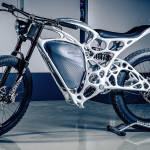
If you’re in the market for a new and unique motorcycle, here’s an option for you: Using a state-of-the-art aluminum alloy powder dubbed “Scalmalloy,” which has “almost the specific strength of titanium,” Airbus subsidiary APWorks would like to introduce you to its “Light Rider.” But Light Rider is more than the world’s lightest and first 3D-printed motorcycle, and Scalmalloy is more than just another aluminum alloy.
Both represent manifestations of research breakthroughs in materials sciences which are transforming the way we utilize metals and minerals. These transformations are fast-paced -– who would have thought commercialized 3D printing would become a reality just a few short years ago? — and we’re quick to accept them as the new normal. But while changing the way we use metals and minerals comes easy, what is lagging is a change in the way we think about metals and minerals, and with that, address them from a policy perspective. Aluminum is a case-in-point.
As we have pointed out over the course of our “Through the Gateway” discussion of Aluminum and its co-products, this metal has not only established itself as one of the key building blocks of our sustainable energy future. Its versatile alloying properties have also placed it at the forefront of cutting edge technologies. And it serves as a gateway to its co-product metals Gallium and Vanadium, which are increasing their footprints with new uses in their own right.
Yet, many still largely think of Aluminum only as a mainstay industrial metal — and of Gallium and Vanadium as somewhat obscure materials – without connecting the dots between them. Connecting the dots, however would be critical, because, as one of the researchers we cited in our Gallium piece earlier this month, so aptly explained:
“(…) some metals that have become deployed for technology only in the last 10 or 20 years are available almost entirely as byproducts. (…) You can’t mine specifically for them; they often exist in small quantities and are used for specialty purposes. And they don’t have any decent substitutes.”
Another aspect that deserves more attention is the geopolitics of resource supply. The case of Copper at the beginning of our campaign struck a theme familiar to ARPN followers, and underscored the importance of pursuing policies conducive to harnessing our domestic mineral resource potential. The case of Aluminum shows that these policies are best coupled with an emphasis on strong trade relations with our closest allies in the context of an integrated North American supply chain to ensure reliable resource supply.
21st Century innovation is moving at lightning speed. Today a 3D-printed lightweight motorcycle using a new aluminum alloy is big news in a field in which so far, Titanium powders have been getting much of the attention. However, we can reasonably expect that Aluminum’s properties will make it a key player in the field of additive metal 3D printing. Research efforts are already underway.
The key to not only being able to keep up but stay ahead of the curve as we race towards our high tech, clean energy future lies in a more comprehensive approach to mineral resource policy. This would help pave the way for more innovative technologies, like the Light Rider, to be developed in the U.S.
Photo credit: APWORKS




